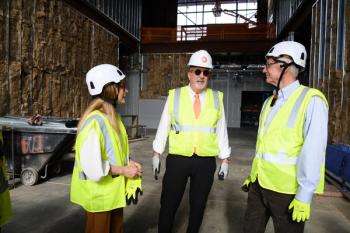
Colleges in crisis
National Report - The downturn in the economy is blamed for deficits, spending cuts and administrative reorganization at some of the nation's leading veterinary colleges.
National Report — The downturn in the economy is blamed for deficits, spending cuts and administrative reorganization at some of the nation's leading veterinary colleges.
Fewer veterinary visits and more guarded spending at veterinary teaching hospitals, coupled with scaled-back state funding, is hurting schools, with two of the largest veterinary colleges drawing attention for their recent belt-tightening.
Colorado State University's veterinary teaching hospital was bailed out of a $1.5 million shortfall last month by the state. A week later, The Ohio State University announced that its hospital faced an $850,000 deficit and would reorganize its administration. Those two schools graduated the two largest classes of new DVMs this year, with 136 and 134, respectively. They are joined by the University of California-Davis, which awarded 114 new DVM degrees this year and predicts a $750,000 deficit when its fiscal year closes June 30.
In 2007, the University of Georgia's College of Veterinary Medicine lost 2 percent of its $55.1 million budget from federal and state cuts of 1 percent each. Other revenue sources stayed about the same, but operating costs were cut from 2006 to 2007, according to the school's annual report. State funding made up 48 percent of Georgia's veterinary-college revenue in 2007 and federal funding contributed 11 percent. Only 4 percent of the school's budget comes from tuition.
These cases may seem like extremes for veterinary education, but those close to the problem say it's just a sign of the times.
"For several years, the Association of American Veterinary Medical Colleges' (AAVMC) members have been addressing just this issue — what is the future for veterinary teaching hospitals? I don't think anyone sees a cookie-cutter right way/wrong way for handling this," says Grant Frazer, director of OSU's veterinary teaching hospital. "It's amazing, when people start talking at annual AAVMC meetings, you can see them nodding around the room. Everyone is wrestling with similar problems."
Private schools seem to do a little better, with the University of Pennsylvania reporting a $3,387 surplus at the close of its 2007 fiscal year. But none of its more than $137 million in revenue is from state or federal funding, according to its annual report.
"A good many of the veterinary schools are facing declining budgets," UC-Davis School of Veterinary Medicine Dean Bennie Osburn says. "Support from the state is not what it has been in the past."
Other factors involved
But not all of the problem lies with federal funding. The natural evolution of the veterinary profession is a factor, AAVMC Executive Director Marguerite Pappaioanou says. Big changes are nothing new in the profession, she says, explaining that there was a large shift to livestock care when people started using cars to get around instead of horses. Then, as farms went from family-owned to corporate, livestock managers started hiring full-time veterinarians for their operations instead of using the local DVM. Now, there is a big change again as people build closer relationships with companion animals.
To respond to this change, more specialty practices are opening throughout the country, allowing companion-animal owners to get complicated procedures done close to home instead of traveling to the nearest veterinary college.
"Forty or 50 years ago, you would have gone to a teaching hospital for complicated procedures. Now, there are a number of veterinary specialty practices that have the facilities, that have the experts, that can do that," Pappaioanou says. "Hospitals are in a bind because they don't want to compete. They want to support the specialists. It's just not a winning scenario for practitioners in the state to think they are losing their clients to the teaching hospitals."
More speciality practices taking difficult cases means smaller caseloads for the hospitals, she says. Fewer caseloads mean fewer experiences for students and less revenue for the teaching hospitals. Combined with declining financial support coming into land-grant colleges from their states and more accountability desired from boards at private hospitals, these factors are putting the crunch on teaching hospitals.
To add another blow, customer service chases some business away from teaching hospitals, Osburn says, because students will take up more of the clients' time than a private practioner would. Plus, the clients coming in don't want to spend as much on services or don't come in as frequently — a problem private practices face, too.
"When you have a lot of people hitting hard times, they are probably going to think three and four times before taking their animals in," Pappaioanou says. "A teaching hospital, all of a sudden then, needs to make enough money to run the hospital. They can't lose money and exist."
In years past, states would help make up any shortfalls, as lawmakers did in Colorado State University's case, but that is more the exception than the rule now.
Looking for new solutions
Still, these problems aren't the end of the world, Pappaioanou says.
"I wouldn't classify this as bad news. It's reality; it's life. And the universities are finding new and better ways to educate in the changing environment," she says, adding that deans from the 28 veterinary colleges have been discussing these issues for years.
One solution may be to change the way veterinary colleges see themselves, Osburn says, explaining that teaching hospitals need to change their business models and operate more like private practices.
Veterinary colleges are going to have to continually test out new management schemes, he says, as The Ohio State University is doing, and new models, like the one in place at the nation's newest veterinary college, Western University.
Instead of having its own teaching hospital, Western University sends students out to local practices for the hands-on portion of their education.
Students see a lot of primary-care cases and few specialty cases, according to Dr. Phil Nelson, dean of the veterinary college at Western University. But they do get real-world experience, he says, adding that the private college pays practices to take on the veterinary students. Since the school is private, he adds, most of its budget comes from internal efforts and tuition, but that doesn't mean Western is completely safe from economic strains.
"We don't suffer the roller-coaster ride of state funding, but we're still exposed to the market, in that if the market affects primary practitioners, it affects the exposure our students will see."
Other ways to succeed
As for other ways teaching hospitals can reinvent themselves, an AAVMC study in 2006, called the Foresight Report, combined the expertise of 95 leaders in the profession who tried to look into the future of veterinary medicine and make predictions for its continued success.
Changes in society to a more global economy with a greater focus on ecological issues is one issue addressed in the study. It points out that, over the past 25 years, 38 new pathogens have emerged, with 75 percent originating as animal diseases. In addition, the emergence of new diseases is happening about every eight months, and "the threat of new zoonotic diseases is very real. ... Of the more than 1,400 pathogens causing human disease, 800 have crossed the species barrier from animals," the study reports.
With more eco-emphasis on lawmakers' plates, the study suggests focusing veterinary medicine on certain expertise areas, specifically in public health, ecosystem health, emergency management and crisis response, plus food safety and security. These new focus areas can help colleges seek new sources of funding through grants from the Department of Homeland Security, governments, private foundations and pharmaceutical companies, the study says.
Thinking outside the box is something the universities facing a crunch already have started to do.
For example, Colorado State lobbied its lawmakers for help and got the university to match the state's $1 million reprieve to avoid layoffs at its teaching hospital. A new software program to save labor hours also is expected to cut the veterinary college's operating costs by about $600,000 a year.
UC-Davis is focusing on offering even more specialty services, increasing its veterinary hospital's efficiency and seeking more support through philanthropy, Osburn says.
At Ohio State, Frazer says the university is helping the teaching hospital in the short term while a three-year recovery plan unfolds. The plan combines an administrative restructuring and new services. The restructuring will affect 23 positions through reclassification, consolidation and elimination.
"I'm very very supportive of the reorganization," OSU College of Veterinary Medicine Dean Thomas Rosol says. "I think it is the right thing to do. I think, nationally, teaching hospitals are evaluating how they need to do business... I think this will make our hospital more efficient."
It's uncertain yet who will be leaving or moving around, Frazer says. The restructuring involves "streamlining" positions that have been the same since the 1960s, says OSU spokeswoman Melissa Weber. Staff members will have the option of looking at the new or changed positions and deciding whether they want to switch job titles, she says. The student experience will remain "status quo" despite the restructuring, Weber promises.
As for new services, Frazer says OSU is offering several new technologies and programs, like teleradiology, canine rehabilitation and a healthy-weight management clinic.
"These programs offer unique services that let the hospital expand its revenue base," Frazer says. "All those things are an attempt to reinvent ourselves."
Newsletter
From exam room tips to practice management insights, get trusted veterinary news delivered straight to your inbox—subscribe to dvm360.




